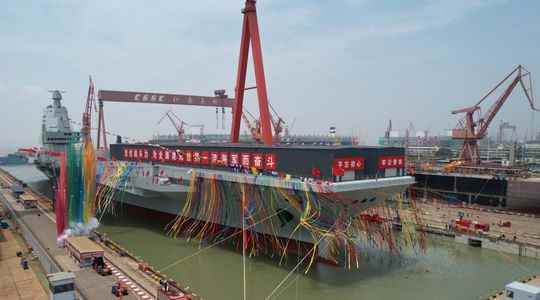China has every intention of joining the very selective club of nations holding an aircraft carrier equipped with CATOBAR technology. To date, only the United States, with eleven “supercarriers”, and France, with its Charles-de-Gaulle, are part of it. On these modern aircraft carriers, the aircraft take off using catapults which allow them to accelerate more quickly and land by means of arresters which slow them down. By launching its third aircraft carrier named “Fujian” on Friday, China intends to strengthen its deterrent and projection capacity.
- The facts: a state-of-the-art but not yet operational Chinese aircraft carrier
After the commissioning of the first Chinese aircraft carrier, the Liaoning, bought in 2012 from Ukraine and dating from the Soviet era, the knowledge accumulated by the country allowed the construction of the Shandong, commissioned at the end of 2019. The he year 2022 thus marks the launch of the second Chinese-made aircraft carrier, much larger and more technologically advanced than its predecessors.
The official New China news agency did not specify the expected date for the entry into service of the building. But it will take many months of sea trials before the Fujian can officially join the Chinese navy, and most certainly several years – embellished with intensive training – for it to reach its full operational capabilities. In question: the significant technological leap made by Beijing. The building will indeed be equipped with a system of electromagnetic catapults, known as EMALS in English, inaugurated on the new American aircraft carrier of the Gerald Ford class, as explained Le Figaro. The other American aircraft carriers and the French Charles-de-Gaulle are equipped with a more traditional system of steam catapults.
To inaugurate this new kind of building, a ceremony worthy of the event was organized with great fanfare in a Shanghai shipyard on Friday. State television CCTV showed hundreds of navy personnel in white shirts, caps and trousers, cheering in a row in front of the aircraft carrier decorated with garlands of pennants and sprayed on either side by huge jets of water . All to the sound of a brass band and under the illumination of fireworks.
- Why it matters: A powerful message sent to the United States and those living around the South China Sea
China has growing economic interests abroad and it will want to secure them. With such a ship, it also sends a message of power to the United States, to the Taiwanese authorities and to the residents of the South China Sea (Japan, Philippines, Vietnam in particular), with which the Asian giant has territorial disputes in the Sea of Eastern or Southern China.
“The Chinese navy is likely to use its aircraft carriers mainly for deterrence in peacetime and for high-intensity missions in wartime,” said Collin Koh, a Chinese military specialist at the University of China. technology from Nanyang, Singapore. “With three aircraft carriers, instead of a token fleet of one or two, it will theoretically have at least one operational at time T, ready for immediate deployment as required by the Chinese leadership.” On the domestic political level, “an aircraft carrier also symbolizes the country’s strength and fuels the Chinese Communist Party’s (CCP) discourse on the great national uplift”, the return of a strong China after decades of underdevelopment. , underlines Collin Koh.
The Chinese navy has several times passed its aircraft carriers through the Taiwan Strait, which separates the Chinese mainland from the island. The name Fuijan was not chosen by chance. As for the two previous aircraft carriers, it is the name of a very particular Chinese province: Fuijan is located just opposite the island of Taiwan, in southeastern China. Beijing is thus keen to remind its competitors of its preeminence in this strategic maritime corridor where Western navies regularly conduct exercises to defend the principle of “freedom of navigation”.
- The context: strong Sino-American tensions around Taiwan
The launch of this third Chinese aircraft carrier comes in a context of strong Sino-American tensions around Taiwan. Beijing considers this island, populated by 24 million inhabitants, as an integral part of its territory, and therefore takes a very dim view of Washington’s strong support for the Taiwanese government, from a party that traditionally advocates independence. compared to China.
On June 10, the Chinese leaders promised to “smash into a thousand pieces” any attempt at Taiwan independence. “If anyone dares to separate Taiwan from China, the Chinese military will not hesitate for a moment to start a war, whatever the cost,” even warned Wu Qian, spokesman for the Ministry of Defense. Chinese, four months after the start of the Russian invasion of Ukraine. The latter reported the remarks of the Minister of Defense Wei Fenghe during a meeting in Singapore with the American Secretary of Defense, Lloyd Austin, on the sidelines of the Shangri-La Dialogue security forum.
If a hypothetical high-intensity conflict were to be triggered in the short term, Fujian would not yet be operational. But it could make the difference by 2030. China is keeping its sights set on the centenary of the People’s Republic in 2049, when Beijing wants to have a “world-class” navy, capable of projecting itself far from the Chinese coasts, to the distant waters of the Pacific or even the Indian Ocean and therefore to compete directly with the US Navy.
